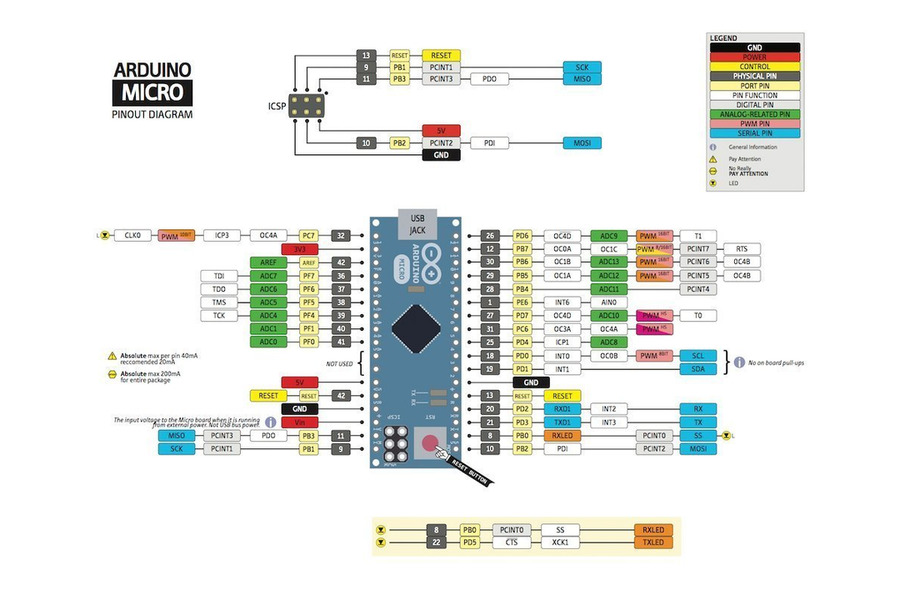

#Arduino nano pinout no 3volts series#
This is enough current to brightly light up an LED (don’t forget the series resistor), or run many sensors, for example, but not enough current to run most relays, solenoids, or motors. Atmega pins can source (provide positive current) or sink (provide negative current) up to 40 mA (milliamps) of current to other devices/circuits.

This means that they can provide a substantial amount of current to other circuits. These pins are also in a low-impedance state. Pins can be configured as OUTPUT with pinMode(pin, OUTPUT), where the pin is the digital pin number you want to initialize as output. It is because there are 20K pull-up resistors built into the Atmega chip that can be accessed from software. If the pin is configured as INPUT_PULLUP during initialization, it inverts the behavior of the INPUT mode, where HIGH means the sensor is OFF and LOW means the sensor is ON. A 10K resistor is a good value for a pull-up or pulldown resistor. This can be done by adding a pull-up resistor (to +5V), or a pulldown resistor (resistor to ground) on the input. Often it is useful to steer an input pin to a known state if no input is present. But it is advisable that one should declare each and every pin as input or output for consistency.ĭigital Input pins can be configured as pinMode(pin, INPUT), where the pin is the digital pin number you want to initialize. Controlling digital pins in Arduino IDE Using the digital pin as InputĮvive digital I/O pins are default assigned as inputs and hence they don’t need to be explicitly declared as input initially in the program. If evive instructs the output to be LOW, it is connected to the ground and produces no voltage. If evive instructs the output to be high, the output will produce a voltage (generally about 5 or 3.3 volts). If the voltage is lower than some value, evive will detect the digital input as LOW/0.ĭigital Output: A digital output allows you to control a voltage with evive. If the voltage is higher than some value, evive will detect the digital input as HIGH/1. Digital Inputs allow a microcontroller to detect logic states, and Digital Outputs allow a microcontroller to output logic states.ĭigital Input: A digital input detects if a voltage is above/below a specific threshold. Nano can do all the tasks that an Arduino Uno or Mega can do but a small form factor makes it quite advantageous for compact projects.Digital I/O stands for Digital Input and Output. Arduino Nano is one of Arduino boards with a small form factor. It is used to connect an external power supply as a reference voltage.ĭifferent boards of the Arduino have different pinout configurations according to which different tasks can be accomplished. RESET: There are two pins labeled as RST, which are used to reset the board.ĪREF: One pin of the Arduino Nano is referred to as an analog reference pin. Ground Pins: There are two pins that can be used as a ground, and they are labeled as “GND”. Power pins: There are 3 different pins providing three different options for the power input and labeled as 5V which means providing constant five volts, Vin which means providing irregular voltage, and 3.3V means providing constant 3.3 volts.

Used for the SPI as a master in slave output (MISO)Īnalog pins: There are 8 pins that are used for the Analog inputs and are labeled as A0 to A7, where A4 and A5 are used by I2C communication, A4 as SDA, and A5 is used by SCL. Used for the SPI as master output slave input (MOSI) and Timer (OC2A)
#Arduino nano pinout no 3volts serial#
Used for the serial communication as receiver RX Used for the serial communication as transmission TX What is the pinout configuration of Arduino NanoĪrduino Nano board contains thirty pins that are used for different purposes, and this usage of the pins is explained in detail in the next sections.ĭigital pins: There are fourteen pins that are used for the Digital inputs/outputs and are labeled as D0 to D13, where some digital pins are used for specific purposes, which are described in the table below: Digital Pins In this write-up, we will explore the pin configuration of the Arduino Nano in detail. In order to understand the Arduino boards and to use them effectively one must first go through the pin configuration of the specific board. Arduino Nano is a microcontroller board that is similar to the Arduino Uno board but small in size and the for readers who are not familiar with microcontrollers microcontrollers are devices that contain a CPU, RAM, ROM, and I/O pins on a single integrated circuit and are used in electronic projects.


 0 kommentar(er)
0 kommentar(er)
